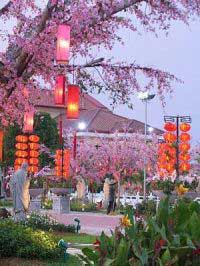AT the Lost World of Tambun, it is the magic of the mountains that beckons first of all.
The enchantment begins as soon as the limestone hills in all their majestic glory are sighted. For those who are attuned to nature, there is a positive buzz, an indication of rejuvenating ions in the rich, oxygen-filled air.
Looking at the scene, one gets the impression that there are a series of hills in the background but according to the locals, the whole range is known by one name, Gunung Dato. It must be mentioned that Gunung Dato is the middle part of an estimated 60km-long limestone massive which stretches from Gunung Gajah in Kuala Dipang to Gunung Kantan in Chemor.
 Fun with a view:Gunung Dato provides an enchanting background to the park.
Fun with a view:Gunung Dato provides an enchanting background to the park. Hymeir Kamarudin, 47, president of the Malaysian Karst Society, says the 448m-high limestone peak that overlooks the theme park is a result of deposited dead sea creatures and other shell animals which have been compressed millions of years ago. It was formed when these heaps were pushed up by land movements and this relatively young hill is believed to have been formed about 400 million years ago.
“What we are seeing is just the tip of the iceberg, as 95% of this limestone hill is still underground,” says Hymeir, hinting that the hill can still “grow”.
Impressive as Gunung Dato may be, the jewel in this theme park’s crown has to be an upright, phallus-shaped 80m-high limestone formation, which has been politely called “The Needle of Tambun”.
Jokes aside, this is possibly a geological wonder – if not a miracle of nature! According to Hymeir, the splitting of limestone formations usually begins with the appearance of fissures and cracks in the wall that can be caused by the combinative elements of temperature change, wind and water. In most cases the fissures are usually jagged and when a split occurs, the shape is inadvertently an irregular one. In this case, by some blessing of nature, the cracks had run along the right lines to give the rock formation a clean split, as if both sides had been cut apart with a knife.
For those who believe in the power of nature, such sights will no doubt be a reminder of its subtle might.
 The best way to suss out the whole place is to take a ride on the train
The best way to suss out the whole place is to take a ride on the train But enough of the view already! Those who have children in tow will quickly be reminded that staring at limestone hills is not the way to spend a day of fun at a theme park.
In an online review, one blogger made a snide remark that the Lost Word of Tambun is a lost case, calling the theme park a boring place with inadequate facilities for the ticket price it charges (RM30 for adult; RM24 for children below 12; FOC for children below 90cm).
Whatever it is that made this blogger unhappy, the first thing to remember when in a theme park is to throw away one’s inhibitions and have fun. Don’t be afraid of getting wet and to tilt your head up and taste the raindrops should it rain.
Never mind about walking around barefoot in wet clothes too – it is the fashion here.
For those with children along, remember that it is also your day to bond with them.
Nevertheless, it is still important to do a bit of planning so you can make full use of the seven to eight hours that you and your family will be there.
There is no fun to being stuck at the sandy bay even if it has a wave pool that generates seven types of wave patterns, or to be put on sentry duty guarding the family’s bags for the whole day. So it is advisable to change into your bathing suits and then chuck everything – towels, wallets, dry clothes, milk powder, baby bottles etc. – into a rented locker (RM10 per unit). That will leave your hands free and your mind at peace. The lockers are programmed to recognise your own specially-created personal identification number so you will not need to carry a key around.
 Thrilling spin: Another way to dry off is to take a ride on the Dragon Flight.
Thrilling spin: Another way to dry off is to take a ride on the Dragon Flight. The next thing to do is to hitch a ride on the vintage train, which is actually a modified tram. This will allow you to list down all the cool hangouts, the petting zoo included. Expect to spend two to three hours at the zoo to allow the children to make an educational connection with the reptiles and mammals there.
Then go for the tube slide or cliff racers rides and have an exhilarating time! Whizzing down any of these four giant slides, or the speed coasters, will surely shift your heart from left to right. We dare the reader to try out the biggest, fully open slide which is 155m in length!
Those with vivid imaginations are bound to feel that they are going to sail right into the air. But don’t worry, at the very worst you’d only end up with a big splash in the pool in the end. For a bit of suspense, try the totally enclosed slide where you zip downwards in total darkness.
Expect to be here for the next two hours as the children will want to go back for numerous rounds. One tactic to get the children to move from this addictively fun spot is to feign a fainting spell, as this writer did, citing vertigo and high blood pressure as excuses.
The 600m adventure river is your next best bet as it is right next to the sliding tubes. Plop in, relax and let the waves carry you along. Prepare to be amused by stone frogs that will spit water at you and look out for a drenching too as there is a giant tipping bucket along the way. You might want to rent one of those round floats (Single for RM18/ Double for RM22; deposit for both are RM10 each) to enjoy this attraction but make sure to keep a close watch over them as they have a tendency to “walk” off.
At the end of the river, there is a children’s wading pool. Here again, you’ll be expected to head the charge as pirate chief while the young ’uns run head first to the water cannons, spraying elephants and slides before clambering on the pirate ships.
Perhaps this is also when mum and dad may want to go at the dry rides at the amusement park. Judging from the thrilling options on offer, it will not need much persuading to herd the children to try these out as well. From personal experience, the swing chair ride is highly recommended.
After a round of thrills, this is perhaps a good time for one parent to visit the hawker stalls while one stands by to keep watch. Though there is no shortage of vigilant (and dishy looking) lifeguards here, there are clear signs to remind parents to keep watch over their brood at all times.
Having a picnic style lunch at the sandy bay is a great way to unwind. This relaxing spot with swaying palm trees is as good as being at the beach and the view of the limestone hills is, again, stunning.
One of the fun things to do in this area is to stand under the fountains and just let the water course down and allow the natural flow to cool and massage your weariness away.
For those who love warm baths, there is the deliciously relaxing hot spring dip by the beach area. As evening draws near and about an hour before the park shuts down, nothing beats a long soak in the hot spring where you can feel the prickly sensation of minerals on your skin.
The hot spring is so popular, the dipping hours have been extended on Fridays and Saturdays (from 6pm to 9pm) and aptly called “Hot Nights”.
For enquiries, call 605-5428 888 visit their website at www.sunwaylostworldoftambun.com.
Published in The Star on Nov 22, 2009



 <<>
<<> The night-time scene is breathtaking >>
The night-time scene is breathtaking >> <<>
<<> Abbot Hui Xian >>
Abbot Hui Xian >>







